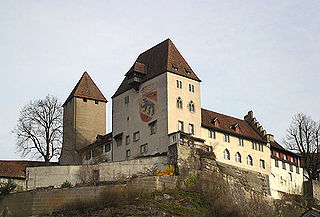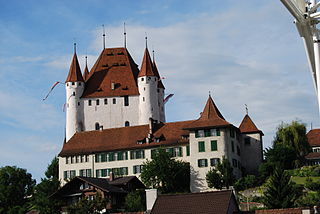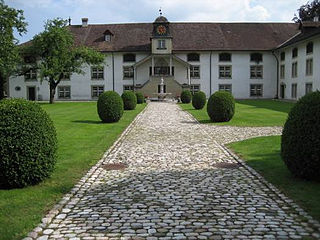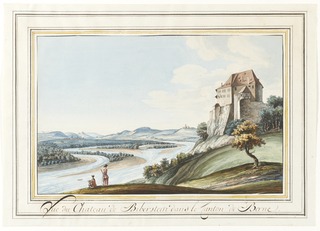
The canton of Bern, or Berne, is one of the 26 cantons forming the Swiss Confederation. Its capital city, Bern, is also the de facto capital of Switzerland. The bear is the heraldic symbol of the canton, displayed on a red-yellow background.

Lenzburg Castle is a castle located above the old part of the town of Lenzburg in the Canton of Aargau, Switzerland. It ranks among the oldest and most important of Switzerland. The castle stands on the almost circular castle hill, which rises approximately 100 m (330 ft) over the surrounding plain but is only about 250 m (820 ft) in diameter. The oldest parts of the castle date to the 11th century, when the Counts of Lenzburg built it as their seat. The castle, its historical museum and the castle hill with its Neolithic burial grounds are listed as heritage sites of national significance.

Kyburg Castle is a castle in Switzerland, overlooking the Töss river about 3 km south-east of Winterthur, in Kyburg municipality, canton of Zürich. It is a Swiss heritage site of national significance.

Nidau is a municipality in the Biel/Bienne administrative district in the canton of Bern in Switzerland.
Wiedlisbach is a municipality in the Oberaargau administrative district in the canton of Bern in Switzerland.

The County of Kyburg probably came into existence in the 11th century and is first mentioned in 1027. After 1053 it was a possession of the counts of Dillingen. It was greatly expanded with the extinction of the House of Lenzburg in 1173.
The Kyburg family was a noble family of grafen (counts) in the Duchy of Swabia, a cadet line of the counts of Dillingen, who in the late 12th and early 13th centuries ruled the County of Kyburg, corresponding to much of what is now Northeastern Switzerland.

The Burgdorferkrieg or Kyburgerkrieg was a war in 1383-84 between the counts of Neu-Kyburg and the city of Bern for supremacy in the County of Burgundy in what is now Switzerland.

Burgdorf Castle is a castle in the municipality of Burgdorf in the canton of Bern in Switzerland. It is a Swiss heritage site of national significance.

Erlach Castle is a castle in the municipality of Erlach of the Canton of Bern in Switzerland. It is a Swiss heritage site of national significance.

Nidau Castle is a castle in the municipality of Nidau of the Canton of Bern in Switzerland. It is a Swiss heritage site of national significance.

Oberhofen Castle is a castle in the municipality of Oberhofen of the Canton of Bern in Switzerland. It is a Swiss heritage site of national significance.

Thun Castle is a castle in the city of Thun, in the Swiss canton of Bern. It was built in the 12th century, today houses the Thun Castle museum, and is a Swiss heritage site of national significance.

Landshut Castle is a castle in the municipality of Utzenstorf of the Canton of Bern in Switzerland. It is a Swiss heritage site of national significance.

Wimmis Castle is a castle in the municipality of Wimmis of the Canton of Bern in Switzerland. It is a Swiss heritage site of national significance.

Erguel Castle is a ruined castle in the municipality of Sonvilier in the canton of Bern in Switzerland. It is the best preserved castle ruin in the French-speaking Bernese Jura.

Fraubrunnen Abbey is a former Cistercian nunnery in the municipality of Fraubrunnen in the canton of Bern, Switzerland.

Wiedlisbach Castle is a former tower house and defensive tower in the municipality of Wiedlisbach of the Canton of Bern in Switzerland.

Trostburg Castle is a small castle in the municipality of Teufenthal in the canton of Aargau in Switzerland.

Biberstein Castle is a castle in the municipality of Biberstein in the Swiss canton of Aargau.






















